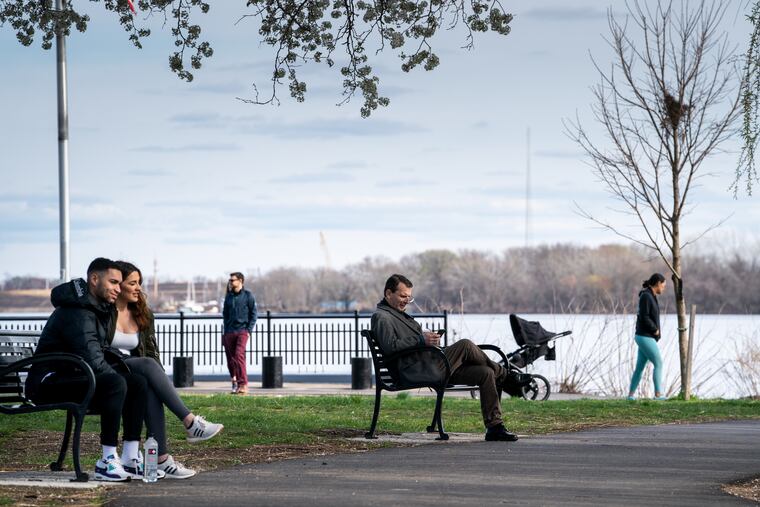Coronavirus is a reminder to value parks and public spaces | Opinion
For now, most Americans can take refuge in one last shared space, vital to the human experience: our parks.

COVID-19 has shuttered the restaurants, beauty salons, libraries, performance spaces, and coffeeshops that have come to define modern urban life. But for now, most Americans can take refuge in one last shared space, vital to the human experience: our parks.
Parks and gardens in Paris, across Italy and Oman, and elsewhere have been shut down. Some National Park Service sites, such as the indoor portions of Independence Hall, are closed because their configuration does not practically allow safe social distancing. Over the weekend, Yosemite National Park, which was getting too crowded, closed too. Some state parks have cordoned off areas that need ranger supervision. New York City will start closing some streets to cars — opening them up instead to pedestrians — and banning contact sports like basketball at parks, Governor Andrew Cuomo announced Wednesday.
But for now, many large-scale green spaces are still open. And thank goodness.
» READ MORE: It’s spring. We want to go outside. How do we safely social distance? | Elizabeth Wellington
The social, environmental, and even economic benefits of parks are well documented by scholars. Although most of us don’t avail ourselves of their benefits on a regular basis, the current crisis has changed our behavior. With gyms closed and work upended, we are flocking to parks, where our bodies and minds can be restored.
Yet for many years, public funding for parks has diminished in an alarming way. President Trump has slashed the national park budget, exacerbating a maintenance backlog that the National Trust for Historic Preservation estimates at nearly $12 billion. Deferred maintenance at state and local parks is harder to peg. Using Pennsylvania as an example, the nonprofit Parks and Forest Foundation has estimated underinvestment totaling $1 billion across the state’s 121 parks and 2.2 million acres of forests.
In the COVID-19 era, we are benefitting most from the spacious parks created during the peak of American park-making, the mid-19th and early-20th century. During that time, new parks were created to offer sunlight and fresh air to the poor huddled masses living in crowded tenements, yearning to breathe. Parks were thought to be a way to help stop the spread of infectious diseases, including tuberculosis. The scale of these carefully-designed grand parks, and the ambitions of their designers, far surpass the vision behind the small-minded “pocket parks” local leaders seem to favor today.
No one did more in the 19th century to advance the notion of parks as transformative to the urban condition than Frederick Law Olmsted, America’s first landscape designer, and a native of Hartford, where I live. He designed New York’s Central Park. In Philadelphia, his legacy lives on at League Island Park (now Franklin Delano Roosevelt Park), designed by his sons.
» READ MORE: How can you responsibly enjoy nature during coronavirus? | Opinion
Olmsted wrote extensively about his design philosophy. He advocated for equitable access to nature, observing that “[t]he great mass of society, including those to whom [the enjoyment of nature] would be of the greatest benefit, is excluded from it.” He viewed exposure to nature as essential to reinvigorating bodily and mental health. To Olmsted, nature had a spiritual element – a view influenced by his family minister, Horace Bushnell.
My own solace during this difficult time is Hartford’s Bushnell Park – the country’s first publicly financed public park, and Horace’s idea. It was designed not by Olmsted, who was too busy with New York’s Central Park, but by one of his close collaborators. My desk overlooks its 50 acres, and I see appropriately socially-distant waving and smiles, and recognition of human connection, as our neighborhood tuba soloist serenades us from a lonely bench.
When COVID-19 has passed, we must collectively push for critical re-investments in national, state, and local park systems. A renewed commitment would honor the 200th anniversary of Olmsted’s birth in just two years.
Philadelphia has already started. Philly officials unveiled plans for an ambitious, $200-million renovation plan for Olmsted’s FDR Park last year. A few years ago, the William Penn Foundation committed tens of millions of dollars to rebuild other park infrastructure. Meanwhile, here in Hartford, the city is investing in sidewalk and lighting improvements for Bushnell Park and has future sights set on restoring the pond, aging pump house, and performance stage.
» READ MORE: Pennsylvania’s state parks have more visitors and less money — and fresh hopes to change that
Other communities should restore the grand historic parks that are getting us through the current crisis and will serve as vibrant places of social cohesion long after COVID-19 is conquered. Special attention should be paid to equity and ensuring that investments are spread fairly across neighborhoods.
Let’s do what we can to renew our commitment to those places that are giving so much right now to our bodies, hearts, and spirits.
Sara Bronin is a UConn Law professor, architect, and advisor to the National Trust for Historic Preservation. @sarabronin